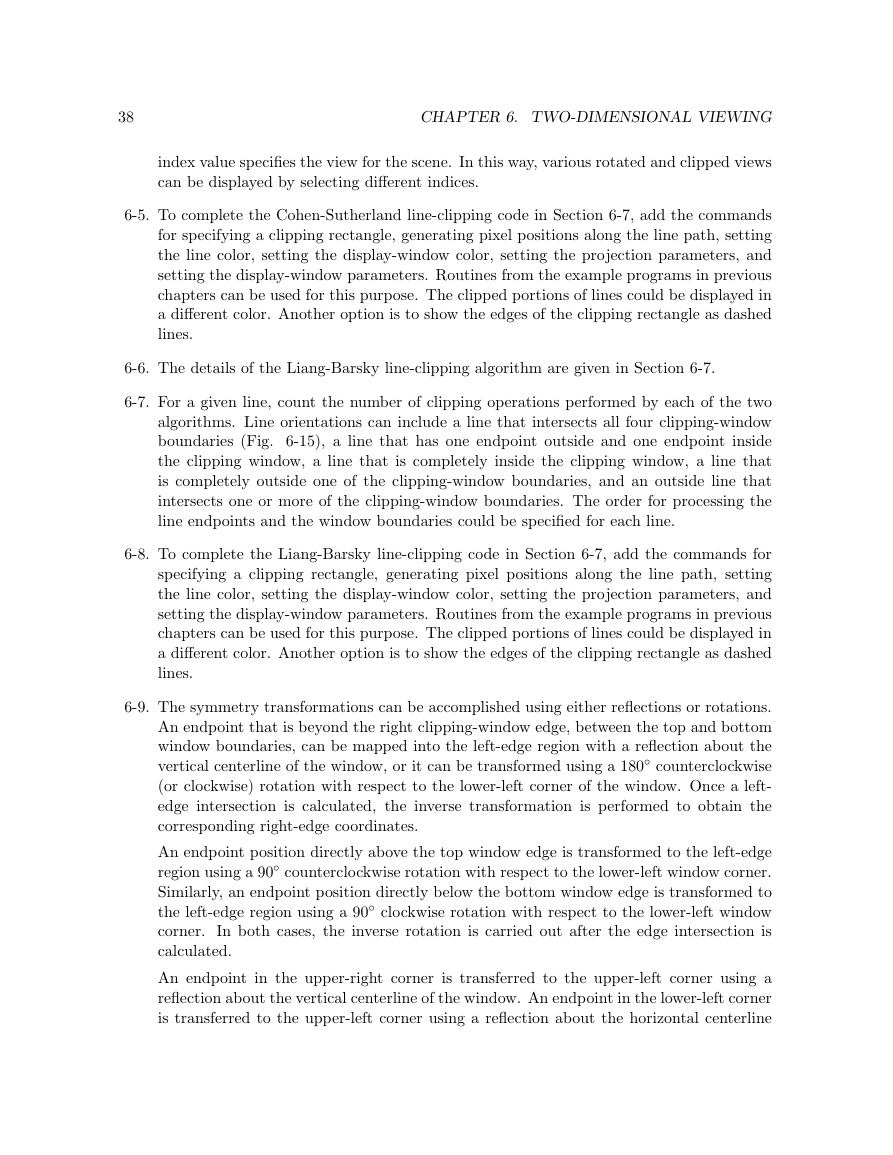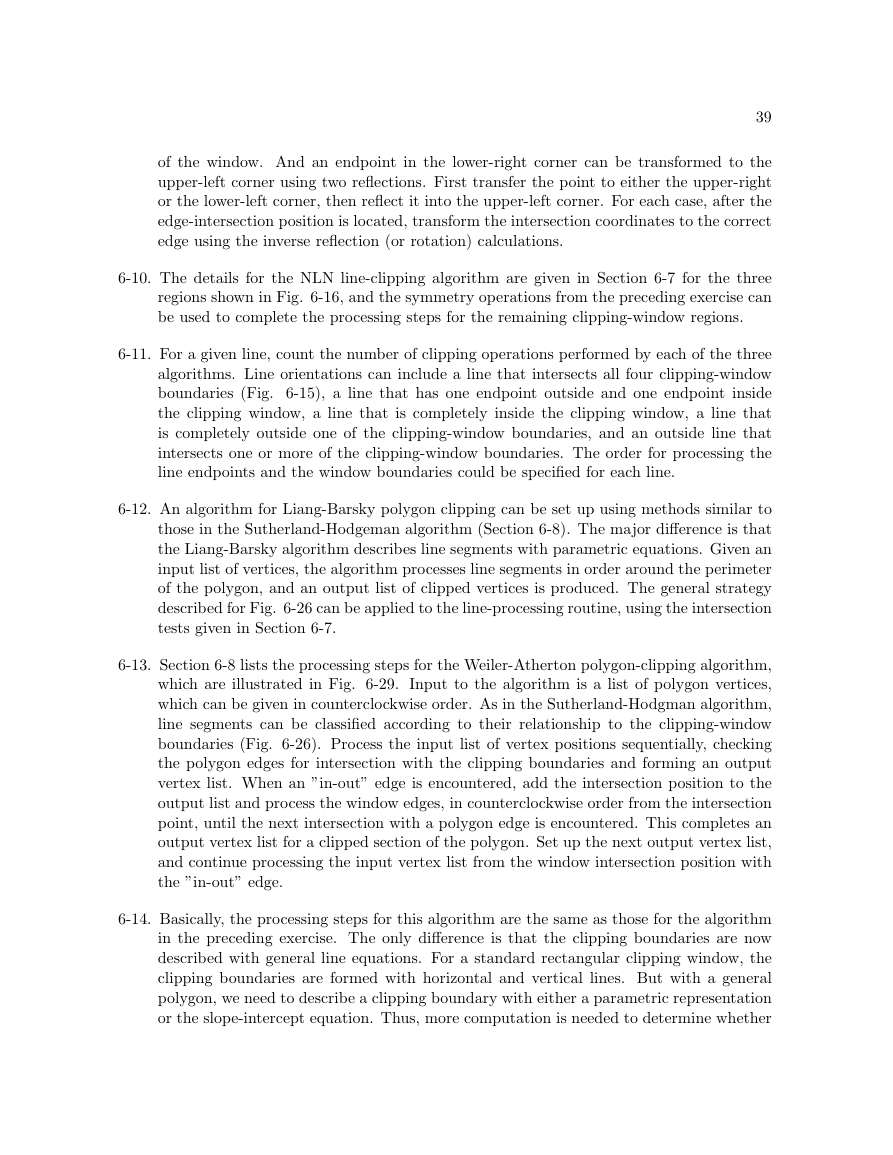Chapter 6
Two-Dimensional Viewing
Exercises for this chapter deal with the two-dimensional viewing pipeline. This includes prob-
lems relating to display windows and viewports, transformations from world to viewing coordi-
nates, clipping procedures, and applications of the OpenGL two-dimension viewing functions.
Exercises
6-1. Matrix 6-1 is formed by first translating P0 to the world coordinate origin, then rotating
the viewing-coordinate axes to align them with the world-coordinate axes. The elements
of the rotation matrix can be obtained from axis vector V using the methods described
in Section 6-2.
6-2. First set up the matrix for scaling the coordinates of the clipping window vertices, relative
to the window center position, so that the window is the same size as the viewport. Next,
premultiply the scaling matrix by a matrix that translates the coordinates of the window
center point to the viewport center point. Then express the elements of the composite
matrix in terms of the scaling and translation parameters in Eqs. 6-4 and 6-5.
6-3. Input to this procedure is the set of coordinates for the clipping-window vertices. The
elements of the transformation matrix are then calculated from a sequence of scale-rotate
operations, as in the preceding exercise. Any position on either the clipping window or
the normalized square can be used as the fixed point for the transformation sequence.
6-4. A circle and a few polygons, such as a triangle, rectangle, and hexagon, can each be defined
relative to the coordinate origin. For example, each polygon could be defined with its
centroid coordinates as (0, 0). Then a scene is constructed by positioning the objects
within a world-coordinate space. Viewing coordinates and a clipping window are defined
using the methods described in Section 6-2, and the normalized-square transformation is
given in Section 6-3.
A viewing table can be set up as a list of values for viewing-coordinate parameters P0
and V (Section 5-8), along with the coordinate limits for the clipping window. Each set
of values can be referenced with a numerical index, such as the list position, and an input
37
�
38
CHAPTER 6. TWO-DIMENSIONAL VIEWING
index value specifies the view for the scene. In this way, various rotated and clipped views
can be displayed by selecting different indices.
6-5. To complete the Cohen-Sutherland line-clipping code in Section 6-7, add the commands
for specifying a clipping rectangle, generating pixel positions along the line path, setting
the line color, setting the display-window color, setting the projection parameters, and
setting the display-window parameters. Routines from the example programs in previous
chapters can be used for this purpose. The clipped portions of lines could be displayed in
a different color. Another option is to show the edges of the clipping rectangle as dashed
lines.
6-6. The details of the Liang-Barsky line-clipping algorithm are given in Section 6-7.
6-7. For a given line, count the number of clipping operations performed by each of the two
algorithms. Line orientations can include a line that intersects all four clipping-window
boundaries (Fig. 6-15), a line that has one endpoint outside and one endpoint inside
the clipping window, a line that is completely inside the clipping window, a line that
is completely outside one of the clipping-window boundaries, and an outside line that
intersects one or more of the clipping-window boundaries. The order for processing the
line endpoints and the window boundaries could be specified for each line.
6-8. To complete the Liang-Barsky line-clipping code in Section 6-7, add the commands for
specifying a clipping rectangle, generating pixel positions along the line path, setting
the line color, setting the display-window color, setting the projection parameters, and
setting the display-window parameters. Routines from the example programs in previous
chapters can be used for this purpose. The clipped portions of lines could be displayed in
a different color. Another option is to show the edges of the clipping rectangle as dashed
lines.
6-9. The symmetry transformations can be accomplished using either reflections or rotations.
An endpoint that is beyond the right clipping-window edge, between the top and bottom
window boundaries, can be mapped into the left-edge region with a reflection about the
vertical centerline of the window, or it can be transformed using a 180◦ counterclockwise
(or clockwise) rotation with respect to the lower-left corner of the window. Once a left-
edge intersection is calculated, the inverse transformation is performed to obtain the
corresponding right-edge coordinates.
An endpoint position directly above the top window edge is transformed to the left-edge
region using a 90◦ counterclockwise rotation with respect to the lower-left window corner.
Similarly, an endpoint position directly below the bottom window edge is transformed to
the left-edge region using a 90◦ clockwise rotation with respect to the lower-left window
corner. In both cases, the inverse rotation is carried out after the edge intersection is
calculated.
An endpoint in the upper-right corner is transferred to the upper-left corner using a
reflection about the vertical centerline of the window. An endpoint in the lower-left corner
is transferred to the upper-left corner using a reflection about the horizontal centerline
�
39
of the window. And an endpoint in the lower-right corner can be transformed to the
upper-left corner using two reflections. First transfer the point to either the upper-right
or the lower-left corner, then reflect it into the upper-left corner. For each case, after the
edge-intersection position is located, transform the intersection coordinates to the correct
edge using the inverse reflection (or rotation) calculations.
6-10. The details for the NLN line-clipping algorithm are given in Section 6-7 for the three
regions shown in Fig. 6-16, and the symmetry operations from the preceding exercise can
be used to complete the processing steps for the remaining clipping-window regions.
6-11. For a given line, count the number of clipping operations performed by each of the three
algorithms. Line orientations can include a line that intersects all four clipping-window
boundaries (Fig. 6-15), a line that has one endpoint outside and one endpoint inside
the clipping window, a line that is completely inside the clipping window, a line that
is completely outside one of the clipping-window boundaries, and an outside line that
intersects one or more of the clipping-window boundaries. The order for processing the
line endpoints and the window boundaries could be specified for each line.
6-12. An algorithm for Liang-Barsky polygon clipping can be set up using methods similar to
those in the Sutherland-Hodgeman algorithm (Section 6-8). The major difference is that
the Liang-Barsky algorithm describes line segments with parametric equations. Given an
input list of vertices, the algorithm processes line segments in order around the perimeter
of the polygon, and an output list of clipped vertices is produced. The general strategy
described for Fig. 6-26 can be applied to the line-processing routine, using the intersection
tests given in Section 6-7.
6-13. Section 6-8 lists the processing steps for the Weiler-Atherton polygon-clipping algorithm,
which are illustrated in Fig. 6-29. Input to the algorithm is a list of polygon vertices,
which can be given in counterclockwise order. As in the Sutherland-Hodgman algorithm,
line segments can be classified according to their relationship to the clipping-window
boundaries (Fig. 6-26). Process the input list of vertex positions sequentially, checking
the polygon edges for intersection with the clipping boundaries and forming an output
vertex list. When an ”in-out” edge is encountered, add the intersection position to the
output list and process the window edges, in counterclockwise order from the intersection
point, until the next intersection with a polygon edge is encountered. This completes an
output vertex list for a clipped section of the polygon. Set up the next output vertex list,
and continue processing the input vertex list from the window intersection position with
the ”in-out” edge.
6-14. Basically, the processing steps for this algorithm are the same as those for the algorithm
in the preceding exercise. The only difference is that the clipping boundaries are now
described with general line equations. For a standard rectangular clipping window, the
clipping boundaries are formed with horizontal and vertical lines. But with a general
polygon, we need to describe a clipping boundary with either a parametric representation
or the slope-intercept equation. Thus, more computation is needed to determine whether
�
40
CHAPTER 6. TWO-DIMENSIONAL VIEWING
two line segments intersect and to locate intersection coordinates. These calculations are
discussed in detail in the solution to Exercise 3-35.
For this exercise, the clipping region is a convex polygon. Therefore, a line segment in
an input polygon fill area can intersect at most two edges of the clipping region.
6-15. This exercise uses the same processing steps as in the preceding exercise. However, for a
concave-polygon clipping region, an edge of an input polygon fill area can intersect more
than one edge of the clipping region.
6-16. First the coordinate extents of the ellipse can be compared to the clipping-window limits.
If there is no overlap, the ellipse is entirely clipped. If the coordinate extents are com-
pletely inside the clipping window, all of the ellipse is displayed. Otherwise, boundary
intersection tests are necessary.
Each of the four clipping-window boundaries can be tested for an intersection with the
ellipse equation 3-37. These intersection calculations determine whether any part of the
ellipse is within the interior of the clipping window. After all ellipse intersections have
been calculated, the portion of the ellipse within the clipping window can be displayed
using the midpoint ellipse algorithm.
Alternatively, each pixel position along the ellipse boundary can be tested for a window
intersection as it is generated, and only those pixels inside the window are displayed. For
a filled ellipse, each scan line across the ellipse can be tested for window intersections.
Sections of each scan line that are outside the window are then clipped.
6-17. All characters are the same width, and the coordinate extents of each character are
compared to the clipping-window boundaries.
If the rectangular limits of a character
are completely inside the window, the character is saved for display. Otherwise, it is
completely clipped. This procedure is applied to each character in a string by stepping
from one character to the next using a fixed-width step size.
6-18. First check the coordinate extents of a character grid against the clipping-window bound-
aries. If the grid is completely inside the window, it is saved for display. If the grid is
completely outside the window, the character is deleted from the display list. Otherwise,
the display includes only those parts of the charter grid that are inside the window. All
pixel positions that are not inside are clipped.
As a modification of this exercise, outline fonts could be clipped. In this case, clipping
procedures are applied to the individual line segments for each character.
�








 2023年江西萍乡中考道德与法治真题及答案.doc
2023年江西萍乡中考道德与法治真题及答案.doc 2012年重庆南川中考生物真题及答案.doc
2012年重庆南川中考生物真题及答案.doc 2013年江西师范大学地理学综合及文艺理论基础考研真题.doc
2013年江西师范大学地理学综合及文艺理论基础考研真题.doc 2020年四川甘孜小升初语文真题及答案I卷.doc
2020年四川甘孜小升初语文真题及答案I卷.doc 2020年注册岩土工程师专业基础考试真题及答案.doc
2020年注册岩土工程师专业基础考试真题及答案.doc 2023-2024学年福建省厦门市九年级上学期数学月考试题及答案.doc
2023-2024学年福建省厦门市九年级上学期数学月考试题及答案.doc 2021-2022学年辽宁省沈阳市大东区九年级上学期语文期末试题及答案.doc
2021-2022学年辽宁省沈阳市大东区九年级上学期语文期末试题及答案.doc 2022-2023学年北京东城区初三第一学期物理期末试卷及答案.doc
2022-2023学年北京东城区初三第一学期物理期末试卷及答案.doc 2018上半年江西教师资格初中地理学科知识与教学能力真题及答案.doc
2018上半年江西教师资格初中地理学科知识与教学能力真题及答案.doc 2012年河北国家公务员申论考试真题及答案-省级.doc
2012年河北国家公务员申论考试真题及答案-省级.doc 2020-2021学年江苏省扬州市江都区邵樊片九年级上学期数学第一次质量检测试题及答案.doc
2020-2021学年江苏省扬州市江都区邵樊片九年级上学期数学第一次质量检测试题及答案.doc 2022下半年黑龙江教师资格证中学综合素质真题及答案.doc
2022下半年黑龙江教师资格证中学综合素质真题及答案.doc